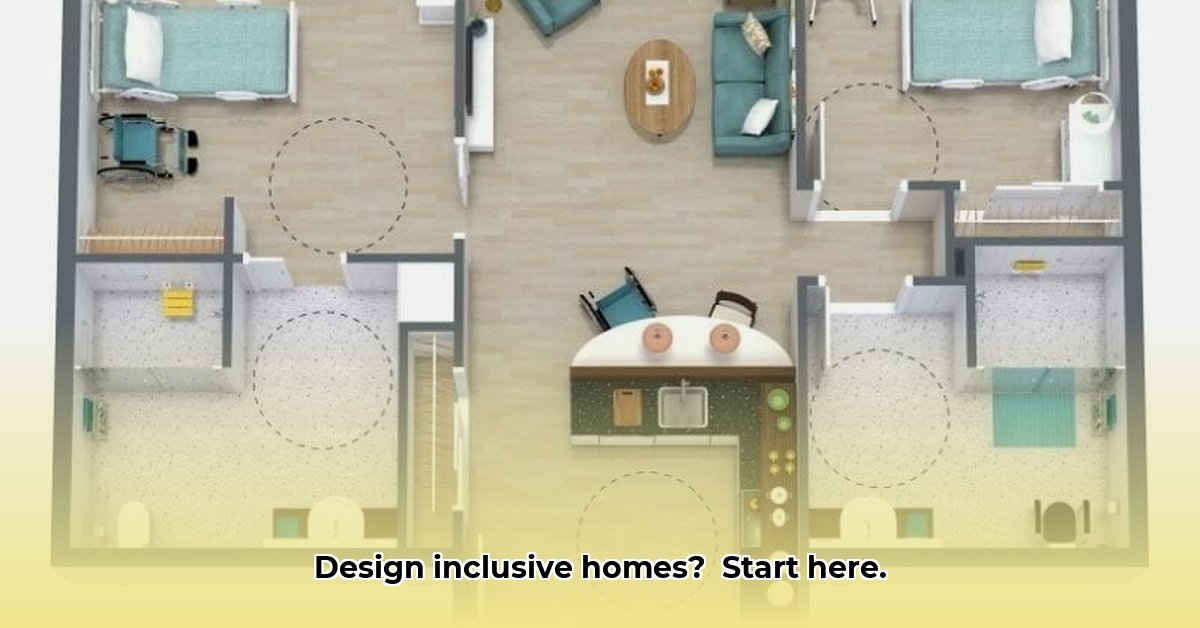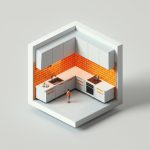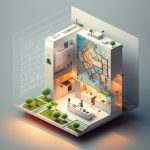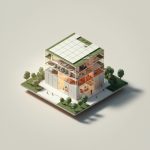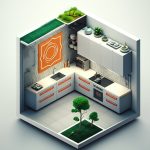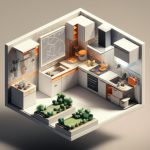Want to build or remodel a home that’s comfortable and easy to use for everyone? This isn’t just about following regulations; it’s about creating a space where people of all abilities can truly thrive. We’ll show you how to design floor plans that are accessible and welcoming, from understanding basic principles to tackling specific challenges like accessible bathrooms and kitchens. We’ll explore different floor plan styles, explain what makes them work (or not work) for accessibility, and provide practical tips for homeowners, builders, and architects. For more adaptable options, check out these flexible floor plan options. Whether you’re planning a new build or adapting an existing home, this guide will give you the information and ideas you need to make your space inclusive and adaptable for years to come.
Accessible Floor Plan Design: Creating Inclusive Homes
Designing an accessible home that uses universal design principles truly welcomes everyone, meaning carefully thinking about how the floor plan is laid out. It’s not just about meeting the bare minimum accessibility rules like ADA compliance (Americans with Disabilities Act); it’s about building a space where everyone feels comfortable and can easily get around. Let’s explore what you need to consider.
Prioritizing Space and Movement: Designing for Easy Flow
Imagine your home as a pathway. A well-designed, accessible floor plan makes that path smooth for everyone, no matter how they move. Think wide doorways and hallways – essential not just for wheelchairs, but also for people using walkers, pushing strollers, or simply carrying groceries. Doorways should be a minimum of 36 inches wide, and hallways at least 42 inches to accommodate mobility devices comfortably.
Open floor plans further enhance maneuverability and prevent that cramped feeling. It’s all about smart design, not sacrificing style! What rooms do people use most? Putting those on the main floor is key for easy access. A master bedroom, bathroom, kitchen, and laundry room all on the ground floor are ideal for aging in place or for anyone who has trouble with stairs. Multi-story homes can quickly become challenging if not planned carefully. Consider the potential needs of everyone who will live in the home, now and in the future. If stairs are unavoidable, consider the possibility of adding a stairlift or elevator in the future.
Bathroom Bliss: Beyond the Basics
Bathrooms are often the trickiest part of accessible design. Roll-in showers are much better than step-in showers in the creation of safe bathing spaces, making it far easier to get in and out. Curbless showers are also an excellent option, minimizing tripping hazards. You need plenty of space – not just for wheelchair users but for anyone who might need assistance. A turning radius of at least 5 feet is recommended.
Grab bars are vital for safety and need to be installed in the right places, near the toilet and inside the shower. They should be securely mounted and able to support a significant amount of weight. Lever-style faucets are much simpler to use than twist knobs, especially for people with limited hand strength or dexterity. Think carefully about where you place toilets and sinks; lower counters make things easier for everyone. A sink with knee space underneath is essential for wheelchair users. Some experts suggest even considering a “comfort height” toilet (17-19 inches from floor to seat) for additional ease of use. There are many creative solutions that can be implemented to create a beautiful and accessible bathroom that increases homeowner independence.
Kitchen Creativity: Accessibility and Functionality Combined
The kitchen – the heart of the home – should be just as accessible. It’s not only about lowering countertops, although that undeniably helps. Consider having different countertop heights to accommodate different users. A section of countertop at 30 inches high is often recommended for wheelchair users.
Storage should be easy to reach – think pull-out shelves and drawers, beneficial for everyone. Where you put appliances matters too; avoid tucking the oven and stove into hard-to-reach corners. Front-loading appliances are generally more accessible than top-loading ones. Consider the placement of frequently used items at easily accessible heights and locations. Some research suggests that pull-out spice racks and adjustable shelves can greatly enhance accessibility. The goal is to create a functional and efficient workspace for everyone. Also, ensure there’s enough clear floor space for maneuvering a wheelchair or other mobility device.
Future-Proofing Your Home: Adaptability for Evolving Needs
Accessible design isn’t a one-size-fits-all solution. Think ahead: what changes might be needed down the line? Designs that can be adapted are crucial; consider features that are easy to add or modify as needs change. Wider doorways and hallways can easily accommodate future needs without major renovations. Reinforced walls in bathrooms allow for easy installation of grab bars later on.
Pre-wiring for assistive technology is also a smart move. This forward-thinking approach significantly increases long-term property value and reduces costly future modifications. Smart home technology, such as voice-activated lighting and temperature control, can greatly enhance accessibility and independence.
Teamwork Makes the Dream Work: Collaborating with Professionals
Designing an accessible home needs teamwork. Work with architects, designers, and occupational therapists who are experienced in accessible design. Their expertise will ensure your vision is realized effectively and efficiently. They can guide you through building codes and accessibility standards, ensuring your design is not only practical but also meets legal requirements. They can also help you explore design choices that might not immediately come to mind, such as appropriate flooring materials and lighting solutions.
The Real Value of Accessible Design: Beyond Compliance
Investing in accessible floor plan design offers more than just meeting regulations. You create a safe, comfortable, and welcoming home for everyone. It boosts property value and improves quality of life. It’s smart design, a forward-thinking decision, and a demonstration of inclusivity. It’s an investment that truly pays off. Some researchers even suggest that homes with thoughtful accessible features are more appealing to a broader range of potential buyers.
What are the key considerations for accessible design?
* Prioritize ample space for easy movement, including wide doorways and hallways.
* Design bathrooms with roll-in showers, grab bars, and accessible fixtures.
* Incorporate accessible storage solutions and adaptable countertops in the kitchen.
* Plan for future needs by including features that can be easily modified or added.
Your Checklist for Accessible Living
This table offers a quick overview of things to keep in mind when planning your home. Remember, these are guidelines, and specific requirements might vary based on local building codes and individual needs.
| Feature | Description | Considerations |
|---|---|---|
| Doorways | Minimum 36 inches wide (often wider is preferred) | Wider doorways enhance maneuverability for everyone, and allow for future adaptations. |
| Hallways | Minimum 42 inches wide; consider turning space for mobility aids | Sufficient turning radius is crucial for safe and easy navigation, especially for wheelchairs. |
| Bathrooms | Roll-in or curbless showers, grab bars, accessible toilet height, lever handles, knee space under sink | Prioritize ease of use and safety for all users. Many design options exist to enhance aesthetics. |
| Kitchen | Accessible counter height (multiple heights desirable), adjustable cabinets, easy-reach storage, front-loading appliances, clear turning space | Consider appliance placement and ensure clear pathways that are accessible and easy to navigate. |
| Living Areas | Ample space for maneuvering, clear pathways, accessible outlets and switches | Ensure ample space for wheelchairs and other mobility devices. |
| Ramps/Elevators | Consider alternatives to stairs; ramps need proper slope and landings, elevators require regular maintenance | Adhere strictly to local building codes and accessibility standards. |
| Flooring | Non-slip surfaces, smooth transitions between rooms | Avoid thresholds or changes in flooring that could create tripping hazards. |
| Lighting | Adequate and adjustable lighting levels | Good lighting is essential for safety and visibility, especially for people with visual impairments. |
Remember: Accessible floor plan design is about creating a home that welcomes everyone. It’s an investment in comfort, safety, and a better quality of life for years to come. It’s a choice that reflects a commitment to inclusivity and thoughtful design.
How to Calculate Long-Term Maintenance Costs for ADA Compliant Accessible Housing Features
Building an accessible home is a rewarding endeavor, but understanding the long-term financial commitment is crucial. Let’s explore how to realistically budget for the ongoing maintenance of these essential features.
Understanding ADA Compliance in Home Design
ADA compliance isn’t a one-time expense; it’s an ongoing commitment. Think of it like owning a car – you pay for the initial purchase, but regular maintenance (oil changes, tire rotations) keeps it running smoothly. Similarly, accessible features require upkeep. Ignoring this leads to costly repairs down the line. What can homeowners do to be proactive? Regular inspections and preventative maintenance are key to minimizing long-term costs.
Key Components of Long-Term Maintenance Costs
Several factors influence the long-term maintenance costs of ADA-compliant features:
- Type of Feature: A ramp requires different maintenance than a roll-in shower. Wood ramps might need repainting or sealing; showers demand regular cleaning and potential repair of components. Elevators require annual inspections and potential repairs to mechanical systems.
- Materials: Durable materials like stainless steel and certain types of tile will last longer than less robust options, reducing replacement costs. But their initial cost may be higher. Composite decking is a low-maintenance alternative to wood for ramps and decks.
- Climate: Harsh weather can accelerate deterioration. A home in a climate with frequent freeze-
- Modern Kitchen Backsplash Ideas To Inspire Your Refresh - December 19, 2025
- Modern Backsplash Ideas: A Guide to Todays Kitchen Trends - December 18, 2025
- Ceramic Kitchen Wall Tiles: Style and Protection for Your Walls - December 17, 2025
